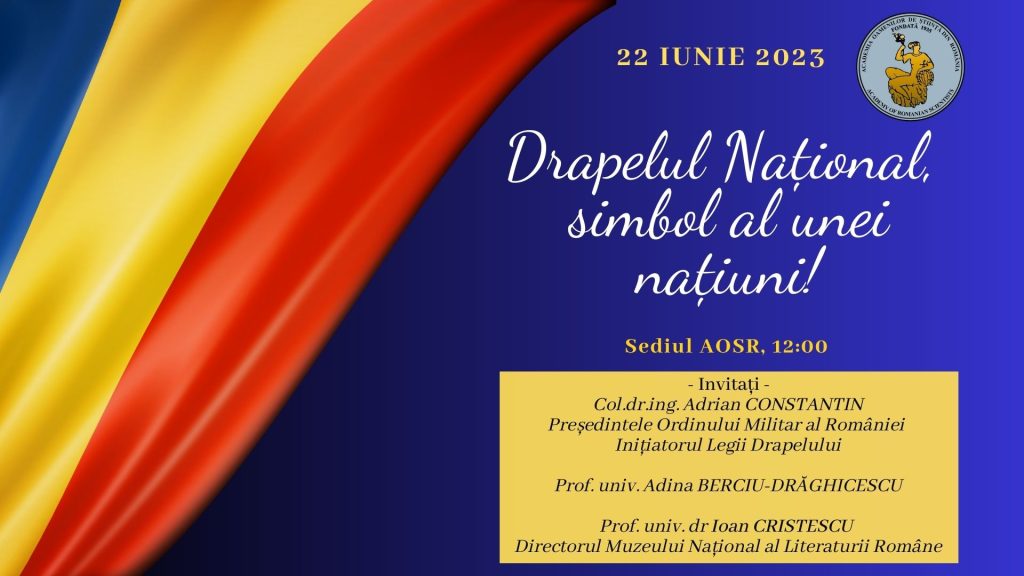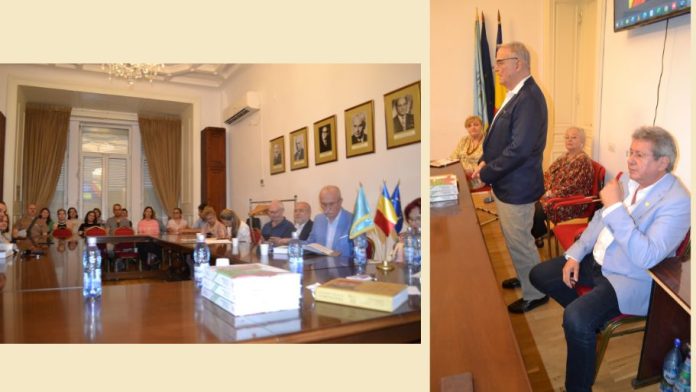The flag, a polarising factor of the nation’s energies
The Academy of Romanian Scientists celebrated the National Flag Day, 26 June, in an event entitled “The Flag – Symbol of a Nation”, which took place on 22 June, starting at 12.00 noon, at the AOSR headquarters. The event was attended by personalities of Romanian culture and science, members of academia, researchers and teachers. Special guests were: Col. dr. eng. Adrian Constantin, President of the Military Order of Romania, Prof. Dr. Adina Berciu-Drăghicescu, Prof. Dr. Ioan Cristescu, Director of the National Museum of Romanian Literature. During the event, the book
The Tricolour in Romanian History
by Adina Berciu-Drăghicescu, Corneliu M. Andonie, Luminița Iordache, published by the National Museum of Romanian Literature.

At the opening of the event, Prof. Dr. Eng. Adrian Badea, President of the Academy of Romanian Scientists, said that the National Flag Day is a day of patriotic emulation, a joyful occasion for all Romanians. Deeply attached to the values of Romanian identity, synergistically integrated in the European concert of unity in diversity, the Academy of Romanian Scientists pays homage with the national flag to the history of the building of Modern Romania through a complex process, carried out with the contribution of some of the country’s elite personalities and with the broad support of the entire nation. Prof. dr. eng. Doina Banciu, Vice President of AOSR and Director General of the Institute for Advanced Interdisciplinary Research “Constantin Angelescu”, referred to the importance of celebrating the National Flag as a symbol of the struggle of a people with ancient roots for survival in a history full of challenges and tragic moments, for independence, development and affirmation as a European nation, alongside the other nations of Europe. The assumption of the symbolic value of the Tricolour in the consciousness of the present generations must be a priority of education, from school to university, of institutions and of society as a whole. Col. dr. eng. Adrian Constantin, President of the Military Order of Romania and initiator of the National Flag Law, spoke about the genesis of the idea of establishing a day dedicated to the Romanian Tricolour and about the legislative process finalized by Law no. 96 of 20 May 1998. At the origin of the initiative was the awareness of the symbolic importance that the Flag has had and still has in the history of Romanian development. The flag has polarized the energies of the people and synthesized their aspirations into cardinal ideals of national evolution, it has accompanied the great moments of our history, the Revolution of Tudor Vladimirescu, the Revolution of 1848, the Union of 1859, under the reign of Alexandru Ioan Cuza, the conquest of Romania’s Independence, the process of creating Modern Romania, the achievement of the Great Union and the creation of Greater Romania and the entire national evolution throughout the last century until today. Prof. Adina Berciu-Drăghicescu presented the book The Tricolour in Romanian History The second revised and added edition, an impressive work by volume and substance, a historical, scientific and cultural monograph of the Romanian flag, seen in its development and metamorphosis over time. In his presentation, he spoke about the differences of interpretation in the recording of historical data generated by the transition to the Gregorian calendar (1919), about the significance of the three colours, about the assumption of the flag at the national level and its contribution to the coagulation of the national consciousness. Prof. Ioan Cristescu, Director of the National Museum of Romanian Literature, presented the work from the point of view of the publisher and the MNLR publishing house, underlining its complexity and value for Romanian history, culture and civilization, for the self-awareness of the present and, especially, for the younger generations.
The event dedicated to the National Flag organized by the Academy of Romanian Scientists was a scientific and cultural event of high academic standing, which highlighted the fundamental role of the Tricolour in mobilizing the conscience and energies of the people throughout history to achieve their aspirations and objectives, its moral value and symbolic force in the evolution of the nation in the present and future.
Communication and Public Relations Office of the Academy of Romanian Scientists
(Contact: comunicare.aosr@gmail.com )
Bucharest, 26.06.2023


